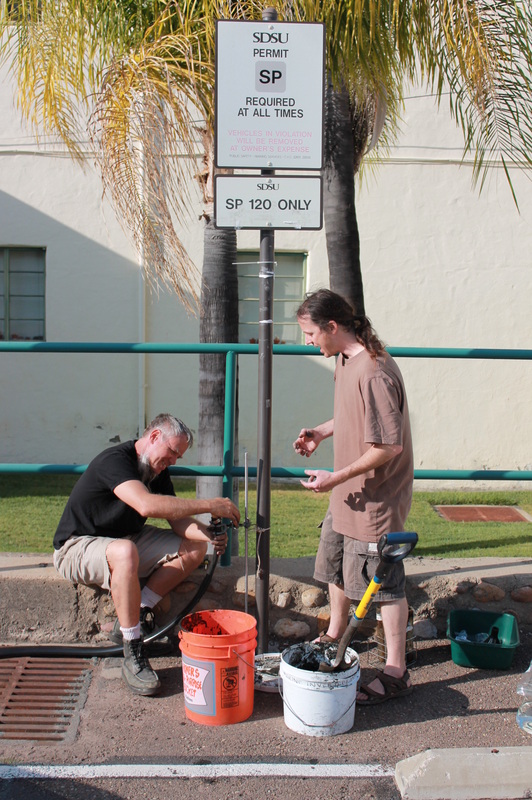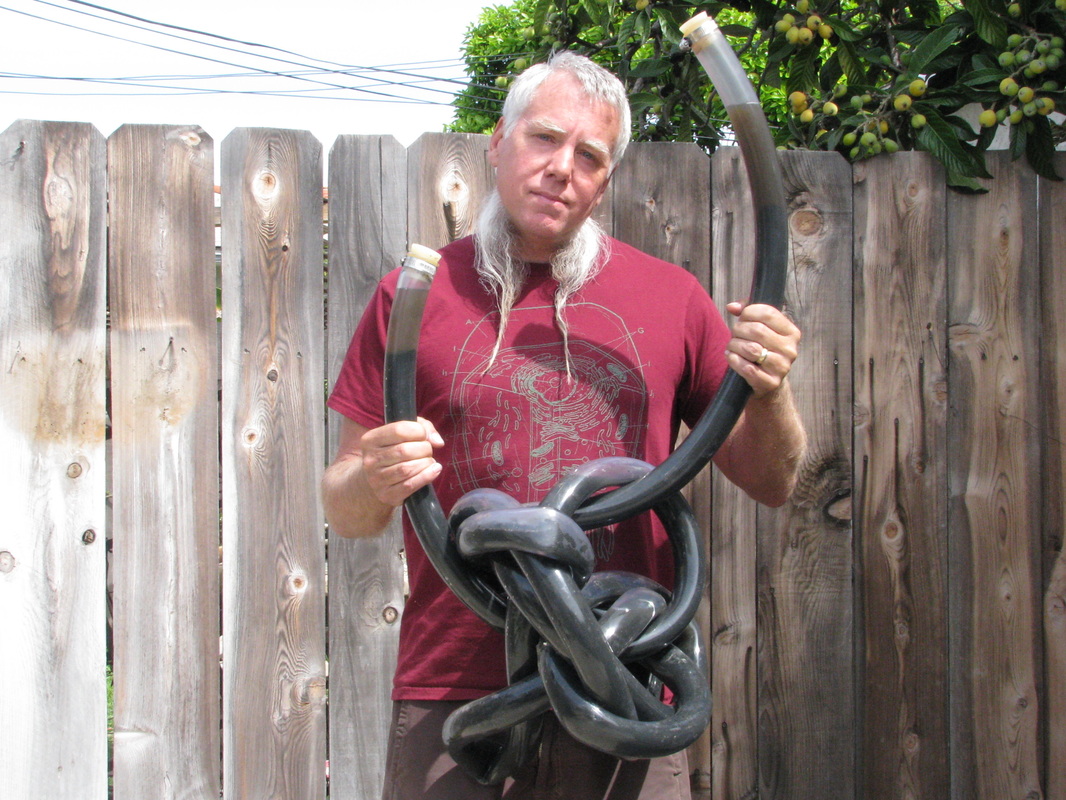Microbial Knot
A project of Urban Succession
This sculpture was primarily developed by artist Jason Rogalski, along with David Lipson, a professor of microbiology at SDSU. It is home to multitudes of microscopic organisms. There are more microbes in one inch of this sculpture than there are humans on the planet. They were collected from mud around the estuary where the San Diego River meets Ocean Beach. This dark soil, teaming with thousands of microbial species, was fed cellulose (energy source), sulfate (electron acceptor for anaerobic respiration), and other mineral nutrients required for growth (ammonium and phosphate). These nutrients will drive the selection of species that are being cultivated inside the woven sculpture. Sulfate-reducing bacteria and photosynthetic purple and green sulfur bacteria are the main groups that we expect to see. Of course, they are microscopic, so we’ll need a microscope to view individuals, but as they multiply, we can expect to see vibrant colors emerge like greens and purples. These are anaerobic organisms, which means that they don’t breathe oxygen. To rid the sculpture of oxygen, David pumped nitrogen gas through the salt water. The sulfate-reducing bacteria (like Desulfovibrio) will break down the cellulose using sulfate instead of oxygen. These organisms exhale hydrogen sulfide. If you sniff the mud you can smell it. The purple and green sulfur bacteria (like Chromatium and Chlorobium) are like plants in that they use light to grow, except they use sulfide as an electron source for photosynthesis rather than water. Together, the sulfate-reducing bacteria and the purple and green bacteria make a complete ecosystem in which elements and waste products are recycled. There are about ten billion organisms per cubic inch.
Click here to view the Microbial Knot's evolution.
We went to the small estuary where the San Diego River meets the Pacific Ocean; O.B.
David waded out into the stinky muck to take readings. His instruments told us that the soil was teaming with microscopic life.
We took turns collecting mud.
We went to Lipson's lab at SDSU, where he teaches microbiology. His focus is on microbes that live in soil.
He tested the salinity of the salt water and Jeremy Gercke came to help with documentation.
He tested the salinity of the salt water and Jeremy Gercke came to help with documentation.
These are anaerobic organisms, which means that they don’t breathe oxygen.
To rid the sculpture of oxygen, David pumped nitrogen gas through the salt water.
To rid the sculpture of oxygen, David pumped nitrogen gas through the salt water.
David instructed Jason to add exact amounts of cellulose (energy source), sulfate (electron acceptor for anaerobic respiration), and other mineral nutrients required for growth (ammonium and phosphate) to the salt water.
Next, we took our prepared salt water and mud out to the SDSU parking lot.
I tied our ring stands to a parking sign for stability and inserted the 20 foot hose into the huge glass funnel.
Lastly, I mixed the salt water into the microbial mud.
I tied our ring stands to a parking sign for stability and inserted the 20 foot hose into the huge glass funnel.
Lastly, I mixed the salt water into the microbial mud.
This part was amazing. We expected that it'd be difficult to get the mud into the hose, but we were wrong. It seemed alive. It seemed to want to flow through the tube.
We corked one end and tightened on a clamp. The other end was left open to allow gas to release while I tied knots.
Lastly, I got to tie knots...this part was very fun.
I corked the other end and brought it home to seek an installation site.
On 4/3/2013, I installed the Microbial Knot at the JCS, San Diego Academy Middle School. Their 7th grade Life Science class will use it as part of their unit that studies microscopic organisms.
I incorporated the Microbial Knot into my Microbiology unit. I presented it to a series of 8 classes.
We discussed it from both artistic & scientific perspectives.
For more details, see the lesson plan under
“Education”on the Urban Succession web site.
http://urbansuccession.com/education.html
We discussed it from both artistic & scientific perspectives.
For more details, see the lesson plan under
“Education”on the Urban Succession web site.
http://urbansuccession.com/education.html
I had masked parts with tin foil, but began to dislike the way it looked, so I went over it with fabrics.
Around the one month mark, students began to notice that areas of the knot were changing color. They pointed out that the top water had turned
pink and this continued into the soil. Deeper in the soil, were layers of a deep red.
pink and this continued into the soil. Deeper in the soil, were layers of a deep red.

